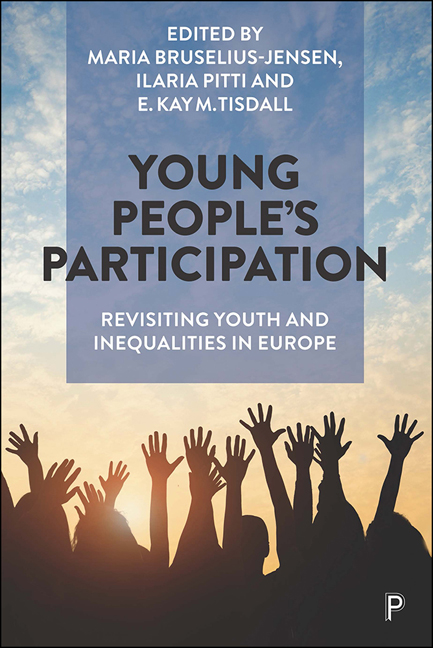Book contents
- Frontmatter
- Contents
- List of figures and tables
- Notes on contributors
- Acknowledgements
- 1 Revisiting young people's participation: an introduction
- PART I Young people's experiences of participation and engagement
- PART II Current state and conditions for young people’s participation: critiques and trends
- PART III Broadening participation: young people's own approaches to participation
- PART IV New opportunities for young people's participation: facilitating new forms of youth participation
- Index
16 - Transformative participation in the lifeworlds of marginalised youth: learning for change
Published online by Cambridge University Press: 18 December 2021
- Frontmatter
- Contents
- List of figures and tables
- Notes on contributors
- Acknowledgements
- 1 Revisiting young people's participation: an introduction
- PART I Young people's experiences of participation and engagement
- PART II Current state and conditions for young people’s participation: critiques and trends
- PART III Broadening participation: young people's own approaches to participation
- PART IV New opportunities for young people's participation: facilitating new forms of youth participation
- Index
Summary
This chapter contributes to discourses of youth participation by developing understanding about which forms of participation might make a difference for marginalised young people living in the context of structural inequality. The chapter critically reflects on some of the complexities and limitations currently at play in relation to enhancing the participation of marginalised young people and sets out key elements of a more critical epistemological framework. Drawing on youth participatory action research (YPAR) and critical utopian action research (CUAR), the chapter makes the case for a transformational learning approach to participation that involves learning and change at both an individual level and professional level in interventions with marginalised young people. The chapter is supported by case-study empirical material focusing on one project developed in collaboration with young people engaged in criminal and violent activities in Denmark. This case study provides an opportunity to reflect on the challenges and possibilities of using ‘alternative’, transformative, action-based interpretations of youth participation and empowerment involving social learning rooted in professional encounters with young people's lifeworlds.
Key findings
• Conventional, formalised approaches and interpretations of youth participation are falling short in terms of efficacy and accountability of policy and professional-led responses to youth marginalisation and inequality.
• Participatory action research offers an alternative possibility for transformative work rooted in the everyday lived realities of marginalised young people rather than professional agendas based on normative assumptions of youth.
• Reconstructing interventions using YPAR and CUAR reframes professional relationships with young people in ways that redress power imbalances and engender co-inquiry and mutual reciprocity in relationships of respect.
Participation of marginalised youth: contesting orthodoxies and assumptions
Austerity across Europe in the past decade has exacerbated the plight of large sections of the youth population already experiencing marginalisation and exclusion at the edge of society (Blackman and Rogers, 2017; Davies, 2019). In Europe, the current numbers of young people in the Not in Employment, Education or Training (NEET) category range from 7% to 24%. At the same time, in the context of post-austerity, inequality has given rise to higher levels of crime, homelessness, poverty and mental health problems for young people in Europe (Horton, 2016) and decreasing levels of participation in education and the labour market (Andersen et al, 2017).
- Type
- Chapter
- Information
- Young People's ParticipationRevisiting Youth and Inequalities in Europe, pp. 275 - 292Publisher: Bristol University PressPrint publication year: 2021

